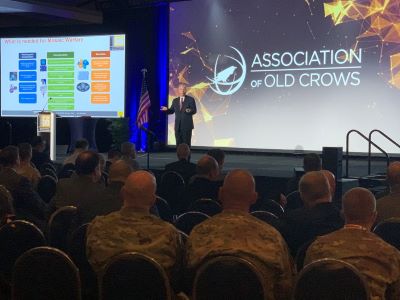DARPA STO Talks "Architecture on Demand" – Mosaic Warfare Concept
Print this Article | Send to Colleague
 |
|
| Dr. Tim Grayson, DARPA |
In continuing with the AOC 56th Symposium theme of "Building the EMS Enterprise," once again, speed of acquisition was a central element of Dr. Tim Grayson's, Director, DARPA Strategic Technology Office (STO), keynote presentation yesterday, and specifically the speed at which adversaries are fielding new capabilities vs. our own cycles. Grayson pointed out that some of these adversaries have actually learned lessons from Silicon Valley – "Do minimum viable products. Take little steps. Pivot. It's a pace of very rapid learning leading to rapid fielding of new capabilities."
Grayson described his shop's approach to the challenge. Known as "Mosaic Warfare," DARPA describes the concept as: "Like the ceramic tiles in mosaics, these individual warfighting platforms are put together to make a larger picture, or in this case, a force package. The idea will be to send so many weapon and sensor platforms at the enemy that its forces are overwhelmed – to take complexity and turn that into an asymmetric advantage"
Grayson says there is a sub-theme within Mosaic Warfare that they call "monolith busting," which is focused on the notion of replacing monolithic platforms with distributed sets of capabilities. "Instead of a self-contained effects chain all on a single platform, the system-of-systems says that elements of the effects chain will be distributed across many sensors and platforms."
In this scenario, says Grayson, "Architecture becomes key," but he warns that, "because developing an architecture is really hard, there is a real danger that says, 'If we try to decide today what that architecture will be that will have to last us for the next 20-30 years, we're going to be in big trouble.'" As a result, Grayson says they're not only trying to bust monolithic platforms with Mosaic Warfare, but to bust monolithic architectures as well. "The objective is to create more diversity of options for the warfighter, but at a speed that allows adaptation – ideally at the time of need."
However, says Grayson, "Mosaic Warfare isn't just about machine to machine, it also applies to human beings." Grayson says the ultimate long-term DARPA vision for Mosaic Warfare is to get to the point where the questions about 'what is the architecture' are left to the warfighter at the operational edge. "So, the uncertainty of what is actually needed is taken off the table. We're trying to build the enabling core technology, the tools and infrastructure to move in that direction – i.e., architecture on demand."
Grayson points out that there isn't an actual program called Mosaic Warfare, but rather a growing and evolving portfolio of programs that feed the concept. "It's a federation of programs that look at things like: What are the functions that are needed to enable this vision? Where do those functions line up against the problem that by itself is useful to a warfighter today? Will we have an identifiable transition path for that particular capability? In aggregate, all of these programs will move us in the direction of mosaic warfare."
Grayson referenced one capability in particular called System-of-Systems Technology Integration Tool Chain for Heterogeneous Electronic Systems, or STITCHES. As stated by Grayson, "We love standards. We love that standards exist. But, we have absolutely zero confidence and extreme cynicism that we will ever figure out how to do universal global standards." STITCHES is intended to address this. Grayson said, "STITCHES is a software tool – think of it like a compiler – that allows warfighters to go in and say, here are the five black boxes that I want to use for this mission today and the set of sorties I will be flying, and I need exactly three out of ten functions from each of those boxes. They then turn to a maintainer that hits 'compile,' and the STITCHES tool auto-generates the glue software, translating between the different standards, where there isn't already existing interoperability."
Summing up the concept and the benefits of the Mosaic Warfare approach, Grayson highlighted that it means, "We don't have to go through a traditional acquisition and a program office to deliver these types of architectures. We can give a tool that can ultimately be used close to the operational edge to generate architecture on demand." – John Haystead

